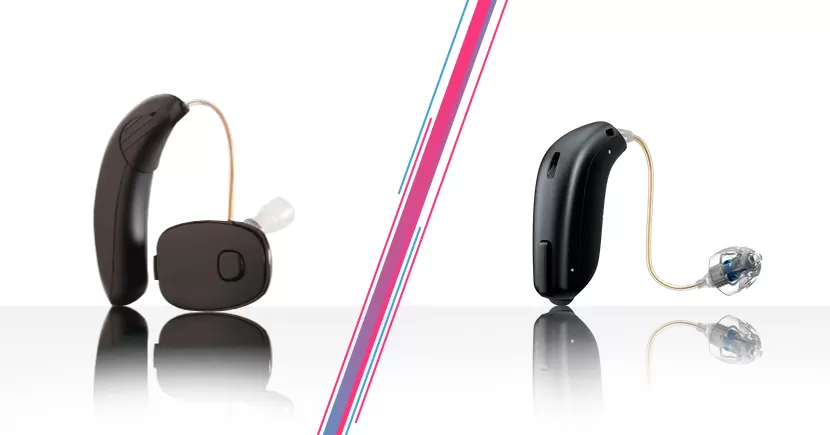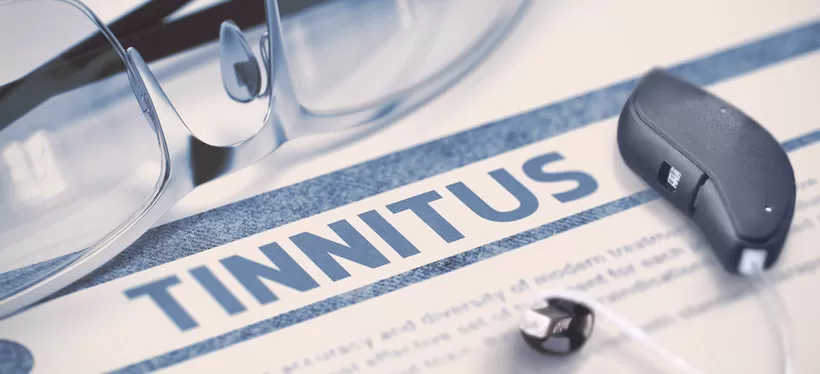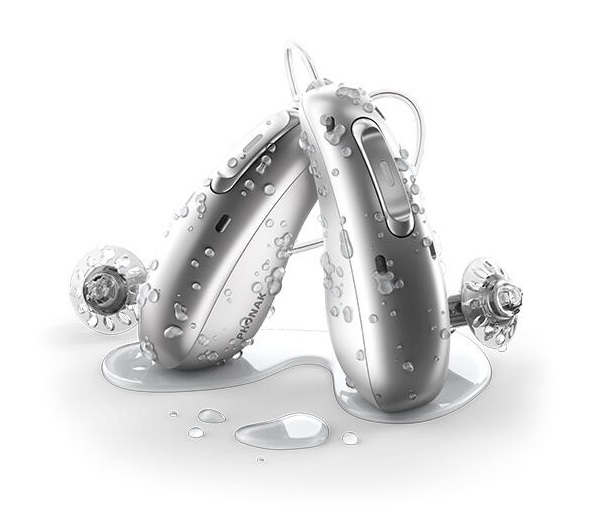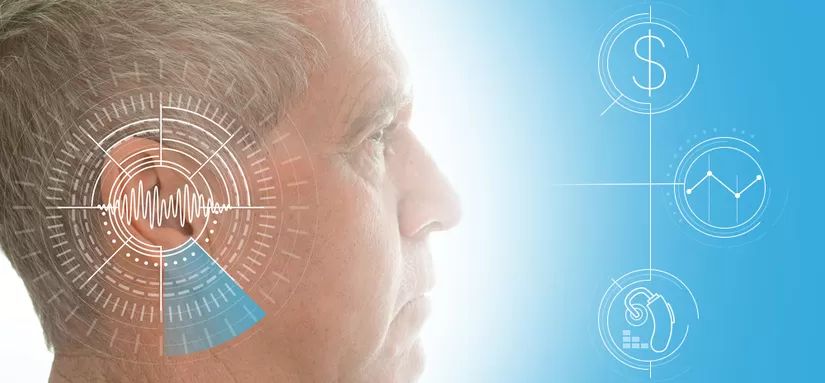Inside Widex Allure: New Chip, New Features, and AI-Driven Crowdsourced Personalization
It’s been five years since Widex’s last major release—2020’s Widex Moment. That was peak COVID—a lifetime ago in hearing aid years—and since then, the industry has been quietly waiting to see what Widex would do next. Now, they’ve officially pulled back the curtain with the announcement of Widex Allure.
And from what we’ve seen so far, this is no minor update. Allure is built on a brand-new platform and a brand new chip, enabling a full suite of next-gen features Widex is calling Precision Hearing Technology. The first device to launch on this platform is the Allure RIC RD—a rechargeable receiver-in-canal hearing aid, available in three technology levels: 440, 330, and 220.

Along with the new platform, Allure brings several meaningful upgrades:
- Rechargeable battery with up to 29 hours of use
- Multiple charging options, including a Charge N Clean system for added hygiene
- Bluetooth LE Audio for next-gen wireless connectivity
- Hands-free calling for iOS and ASHA streaming for Android
- Future-ready design, with an upcoming firmware update for Auracast support
If you’re looking for the topline promise, it’s this: crystal-clear speech, immersive natural sound, and AI-powered personalization—all in a device that’s intuitive, flexible, and built for what’s next.
So, has Allure been worth the wait?
In this article, I’ll break down what’s new, what Widex is claiming, and share my experience wearing Allure for a week—comparing it to flagship models from other leading brands I’ve also worn and tested.
What’s new with Widex Allure
New W1 Chip
At the core of Widex Allure is the all-new W1 chip, built with a single-chip architecture that’s 4× faster and has 4× more memory than the previous-generation Moment platform—according to Widex. That added horsepower overcomes previous performance limitations, allowing Allure to run more advanced features simultaneously without compromise. In earlier models, Widex often had to make trade-offs between speed and feature complexity. With W1, those constraints are gone. This kind of processing power and multitasking wasn’t possible before, and it’s what makes it possible to launch not just one, but five new features that work together as part of what Widex calls Precision Hearing Technology.
Precision Hearing Technology
Thanks to the power of the new W1 chip, Widex didn’t just upgrade one part of the hearing experience—they introduced an entire suite of new and improved features that work together behind the scenes. This collection is called Precision Hearing Technology, and it’s designed to make hearing feel more natural, more stable, and less effortful throughout the day. Some of these features are entirely new, others are major upgrades to existing systems, but all five contribute to how Allure balances speech clarity with natural environmental sound. Below, we’ll break down each of the five features that make up Precision Hearing Technology—in our perceived order of importance.
New Feature #1: Speech Enhancer Pro
Hearing speech in noise remains the biggest challenge for hearing aid wearers—and manufacturers take different approaches to solving it. Many now rely on deep neural networks (DNNs) that analyze sound in real time and make adaptive changes to suppress background noise. While these systems can be effective, Widex states they can also result in overly aggressive processing that may compromise sound quality or reduce awareness of the surrounding environment. Widex takes what it describes as a more measured approach: one focused on maintaining speech clarity and sound naturalness, even in complex environments.
That philosophy is reflected in Speech Enhancer Pro, a key feature in the Widex Allure hearing aids. It uses a 52-band spectral analysis system—think of it like a sound “equalizer” with 52 tiny sliders, each tuned to a specific slice of the sound spectrum. This gives the hearing aid fine-grained control to separate speech from background noise with more precision than broader, less detailed systems. The processor then boosts speech while softening unwanted noise, without making the overall sound feel processed or artificial.
Speech Enhancer Pro still incorporates AI, like the DNN-based systems used by competitors, but it’s built on a different foundation. Instead of applying real-time neural network processing, Widex uses AI-trained sound classification—based on seven years of real-world user data—to identify the listening environment and types of noise. From there, it applies what Widex considers more predictable, carefully balanced adjustments to optimize the listening experience.
As a bonus, Speech Enhancer Pro is always running in the background—it doesn’t need to be manually activated or assigned to a specific program, unlike some competitor systems that only engage manually or in certain programs or environments. According to Widex,Speech Enhancer Pro led to a 92% preference among users in noisy situations, with 96% reporting reduced noise annoyance. That’s based on internal clinical studies—we’ll take a closer look at those claims in a moment.
New Feature #2: Enhanced Sound Classifier
The Enhanced Sound Classifier in Widex Allure helps the hearing aid better recognize and adapt to different listening environments—like quiet rooms, busy cafés, or live music venues. Think of it as the hearing aid’s built-in “scene detector.” It uses rapid sound analysis and a specialized beat detector, which is designed to recognize rhythmic patterns, like music, more accurately. This helps prevent common misclassifications—for example, mistaking background music for noise—so the hearing aid can apply the right settings for the situation.
The system automatically switches between 11 distinct sound classes, more than most hearing aids on the market. These transitions happen smoothly and in real time, without the user needing to press buttons or change programs. The goal is to make the hearing experience so natural and stable that you forget you're even wearing hearing aids—letting you stay focused on conversations, music, or whatever moment you’re in.
New Feature #3: Adaptive Dynamic Feedback Controller
The Adaptive Dynamic Feedback Controller in Widex Allure is designed to tackle one of the most frustrating issues for hearing aid wearers: feedback—those high-pitched whistles that can happen when sound from the speaker loops back into the microphone. Allure’s system uses adaptive frequency shifting, meaning it can subtly change the pitch of the sound in real time to break that loop without distorting what you hear. Think of it like adjusting the angle of a mirror to stop light from bouncing back into your eyes—except here, it’s adjusting sound to avoid the squeal.
This is especially helpful for open-fit wearers and music listeners, where feedback risk is higher. Historically, in my opinion Widex hasn’t been the strongest in this area, but early user testing shows promise: the new system was preferred four times more often compared to previous versions. We’ll take a closer look at that claim in a moment, but the bottom line is—while all hearing aids whistle from time to time—Widex is getting better at managing it.
New Feature #4: Allure PureSound
When Widex launched ZeroDelay technology with the Moment platform in 2020, it changed how hearing aids handled sound. Most hearing aids have a processing delay of 2 to 8 milliseconds—long enough for amplified sound to clash with the natural sound entering the ear, especially in open-fit styles. That mismatch can create distortion or a hollow, “tinny” quality that many wearers describe as unnatural. Widex solved this by cutting delay down to just 0.5 milliseconds, virtually eliminating that mismatch and delivering a clearer, more transparent sound through what became known as the PureSound program.

However, to keep that sound as natural as possible, the original PureSound program had to run without some of the hearing aid’s more advanced features. That meant when you were in the PureSound program, tools like noise reduction, directional microphones, and feedback control weren’t active. In other words, you got a very clean and lifelike sound—but with less support in noisy or complex environments.
The new Widex Allure PureSound changes that. It keeps the same ultra-fast 0.5 ms processing delay, but now allows all those advanced features to run at the same time. That includes things like broadband beamforming to focus on speech, adaptive noise management, and feedback suppression. The result, according to Widex, is a 4.3 dB improvement in speech understanding in noise compared to the original PureSound program. That’s a significant upgrade—and we’ll take a closer look at that claim in a moment.
New Feature #5: Allure Dedicated Streaming Compressor
If you’ve worn hearing aids before and streamed music, podcasts, or phone calls, you might have noticed the sound occasionally cuts in and out, gets too quiet, or competes with background noise around you. It can feel like your streaming is fighting with your surroundings—especially in noisy places. The Dedicated Streaming Compressor in Widex Allure addresses this by treating streamed audio and microphone input as two separate signals. Think of it like having a dual-lane road—one lane for streaming, one for your environment—so they don’t interfere with each other. The system automatically smooths out volume fluctuations and minimizes background noise during streaming, delivering a more natural and consistent listening experience. Whether you're on a call in a busy café or listening to music at home, it helps keep your focus on what you actually want to hear.
Honorable Mention: Widex Compass Cloud—the world’s first cloud-based fitting software
Fitting software is what your provider uses to program your hearing aids—and normally, it’s not something you’d ever need to think about. But with Widex Compass Cloud, it actually benefits you. Because it’s cloud-based, your provider is always working with the most up-to-date version—no need for them to remember software updates or manually push firmware to your hearing aids. That means you get a more accurate fit from the start, fewer adjustments down the line, and the confidence that your hearing aids are always running the latest tech.
Examining the Claims
Before we break these down, one thing that stands out: Widex isn’t making vague claims about outperforming “unnamed leading competitors.” The studies below that produced these claims all compare Widex Allure to Widex Moment—their own previous generation product. And honestly, that feels refreshing. It’s not marketing fluff; it’s just, “we’re better than we used to be.” That kind of internal progress tells us two things: 1) they’re being transparent, and 2) the tech really is evolving in measurable ways.
Claim #1: Allure PureSound processing now delivers significantly enhanced speech intelligibility in noise — an improvement of 4.3 dB SNR.
This claim is backed by Widex’s internal study, which showed participants understood speech better in noisy environments when using Allure PureSound compared to the older PureSound program. The improvement was statistically significant and consistent across nearly all participants.
Here’s a key detail: the earlier PureSound program in Moment didn’t include directional microphones. It was focused on delivering ultra-low processing delay (0.5 ms) for natural sound, but it couldn’t run directional processing at the same time. Allure changes that. It combines directionality and ultra-low delay in a single program—something Moment couldn’t do.
So the 4.3 dB improvement comes from finally being able to use directional microphones within a low-delay program. That’s a meaningful technical step forward.
Claim #2: 92% of users preferred Allure in noisy situations over the previous platform.
This claim comes from a Widex study where 25 experienced hearing aid users listened to recordings from three noisy environments—a lounge bar, a restaurant, and a train station—all with speech mixed in at a realistic volume. Participants were asked to compare two recordings and pick the one they liked better, a simple A/B test.
92% of participants preferred the Allure recordings. Driving that preference is Allure’s new Speech Enhancer Pro, a noise reduction system the previous generation didn’t have. If there’s any critique, it’s that this study was conducted in a lab with recordings played over headphones, not real-life use with actual hearing aids, and with only 25 participants. Even so, the claim holds up. It’s a solid comparison with real-ish noise, and Allure comes out ahead.
Claim #3: The new Dynamic Feedback Controller is preferred four times more often.
This claim comes from a Widex study comparing Allure’s new Adaptive Dynamic Feedback Controller feature against the older Widex Moment. They tested it with 25 hearing aid users who listened to speech recordings where feedback—like that annoying whistle—kicked in as a phone simulator moved close (0, 5, 10 mm) to a dummy head wearing the aids. In a straightforward “which sounds better” test, Allure won big: 83% picked it over Moment’s 17%. That means people liked Allure almost five times more, which rounds down to the “four times” claim.
Widex Allure Expert Review
How Allure Looks, Fits, and Feels
Dimensions: (LxWxD) 29.2mm x 7.2mm x 13.1mm
Weight: 3.08g
Like all receiver-in-canal style hearing aids, Allure fits very comfortably and discreetly. At just 3.08g in weight, I can hardly feel it on my ear, and usually within a few minutes of putting the hearing aids on I would forget I was wearing them.

That said, it’s far from the smallest on the market. It’s not big by any means, but when I compared it by overall volume to the other 6 leading flagship hearing aids on the market, it’s bigger than 4 of the 6, in other words, out of the most popular and well-known prescription hearing aids on the market, it’s the second-biggest.
How they were programmed
I had my Allure hearing aids programmed by a Widex Product Manager/Audiologist.
I requested that they be programmed in the same way I program all other hearing aids that I review.
Program 1: Universal. This is the program that uses the Enhanced Sound Classifier that was mentioned earlier. It’s the hearing aid’s built-in “scene-detector” which automatically classifies the sound environment and then transitions the hearing aids into a program specifically tailored to that listening environment. When in this program, the hearing aids will simply ‘do their thing’, requiring no intervention from me.
Program 2: Universal (edited): I requested this program so I could manually test Allure’s most aggressive noise reduction. In this program, several settings to clarify speech in noise were adjusted.
This is a very common programming setup—the majority of Allure wearers will use the Universal program in slot 1, and custom manual programs in the others, but the majority of the time the hearing aids are in use (>90%), they’ll be in the Universal program.

Important note when it comes to getting your Allure hearing aids programmed—Allure hearing aids cannot be remotely programmed by a hearing care provider; all programming must be done in-person by your local hearing care provider.
This marks a return to the standard of in-person care. While remote programming became common during COVID-19, it also led to a rise in direct-to-consumer sellers who lack the ability to offer hands-on support. Be cautious when buying Allure from these online and ‘remote care’ sellers—you’ll need to mail in your hearing aids for any adjustments.
General observations and first impressions
The first things I usually pay attention to with any hearing aids I try are how much echo I hear in my own voice, and how much machine noise—also known as circuit noise—I hear from the hearing aids.
In both of those areas I would categorize Allure as average. I did notice a slight white noise when wearing them (you may not depending on your hearing loss), but no more than several major competitor products. The same is true with hearing the echo—which most people get used to in short order.
My hearing felt superhuman
Since my hearing is mostly normal, I had these programmed to provide minimal amplification for me—mostly just in the high frequencies to make speech more clear.
Even still, I was shocked at the level of help they provided.
If you haven’t heard the birds in a while, you’re going to be blown away by birdsong. You also shouldn’t be surprised if you hear things that you’re not sure you’re supposed to be hearing—like conversation at a quiet level across the room. There are times where your hearing will feel superhuman—maybe too good, and it will take some getting used to—but I promise, it’s better than the alternative.
The Enhanced Sound Classifier works very well
Anytime I moved from one environment to the next, whether it was a quiet room to a room with talking, indoors to outdoors, etc, I would hear the hearing aids switching/adjusting themselves—it takes about 2 or 3 seconds. It’s cool to know that the hearing aids are actively working to give me the best sound depending on my environment, without needing any involvement on my end
Having said that, 20 years ago when this automatic program switching tech was brand new I thought it was cool and I wanted to hear the hearing aids actively working/switching, but now that this tech has settled in and become mainstream, I prefer it to be less-noticeable.
Wind Noise
On a breezy afternoon walk, nothing major, just about 5mph, I noticed something that’s all too familiar. Every couple of minutes, when the wind hit just right, I’d catch that scratchy, rustling sound through the microphones. In my experience, the default wind noise reduction on Allure works about the same as most competitor hearing aids: decent, but wind still finds its way through from time to time.
Now, Widex says Allure features a new microphone cover that is "wind and touch resistant." The wind part is meant to reduce wind noise, while the touch resistance aims to minimize that scratchy interference you sometimes get when your hair brushes against the microphones. I was hopeful, but in real-world use, I still heard those scratchy sounds from hair, just like I do with every other hearing aid I’ve worn. So as for “wind and touch resistance” I didn’t notice any real improvement, until…
AI Assistants to the rescue
Allure hearing aids have two “AI Assistants” built into them, accessible through the Allure app when things aren’t sounding quite right.
The first, and fastest, is called the AI Quick Assistant. You’ll find it by tapping “+ Adjust sound” in the app, then choosing “AI Quick Assistant.” It asks what activity you’re doing and then pulls settings from Widex’s cloud-based system, using data from other users in similar environments. It’s a one-way exchange—you get the benefit of what has worked for others, instantly.
For example when I was bothered by wind noise, I chose "Outdoors," and whatever it adjusted behind the scenes definitely helped. Wind interference dropped off noticeably, and the overall listening experience felt much more comfortable. It seems to apply a more aggressive wind reduction profile in that context, which made a real difference.
If the AI Quick Assistant isn’t enough, there’s also an AI Sound Assistant
This one is a little more hands-on. Instead of applying changes right away, it guides you through a series of A/B comparisons and asks which version you prefer. It takes a few extra seconds, but the trade-off is more personalized fine-tuning. And unlike the Quick Assistant, your responses actually get fed back into Widex’s system, helping to improve recommendations not just for you, but for other Allure users as well. It’s more of a two-way exchange, where your preferences help shape the system over time.

Both assistants are powered by what Widex calls real-time machine learning. And here’s something important: unlike many hearing aids today that are built around an embedded deep neural network (DNN), Allure takes a different approach. Widex chose not to embed a DNN in the hearing aid itself. Instead, they’ve offloaded the processing to the Allure app on your smartphone, which connects to a powerful cloud-based learning engine.
Why does that matter? Widex says it allows the hearing aids to remain small, light, and incredibly power-efficient. There’s no bulky processor inside the device pulling extra battery. And second, it means Widex can continue improving your experience over time by updating the cloud engine, rather than locking users into a fixed DNN baked into the hardware. In other words, the personalization evolves with you—and with every other Allure user.
That being said, I'm not sure how much I'd actually use this feature. If you're not hearing like you should, you have to basically excuse yourself from conversation for a few minutes to play with this feature, which is something I found akward and uncomfortable.
Hearing in Noise
I really put these hearing aids through their paces in noise, and here are my main takeaways:
The directional microphone focus feature works wildly well
In the Allure app, you can choose which directions the microphones focus on. For me, selecting the front focus made it much easier for me to focus on what the person I was facing was saying. You can select the microphone directionality focus inside the app, or your hearing provider can program that into your Allure hearing aids, so anytime you’re in a particular program, the focus will be how you’d like.
It’s worth it to make custom programs
When wearing the hearing aids in the Universal program, in noise I wasn’t blown away by the speech clarity of people I was trying to focus on, or on the background noise reduction. It wasn’t until I made a custom program and tweaked the settings a bit that I started to get that “tunnel vision” hearing that I like from hearing aids- where I feel like they are narrowly focused on exactly what I’m looking at, and making that speech louder than the surrounding noise.
A word of warning about custom programs—things can get wonky quickly and you can ‘stray too far from home’ (the settings your hearing care provider has set). Luckily, there is an easy ‘reset’ button when you make adjustments, letting you get back to the baseline settings of the hearing aids.
Bluetooth Connectivity, Streaming, & Hands-Free Phone Calls
Allure hearing aids support Bluetooth LE Audio, the next generation Bluetooth protocol, which among other benefits promises improved streaming sound quality, better battery life, and reduced latency.
Unfortunately, not many phones have Bluetooth LE Audio yet (including the iPhone, which I use). If having functional Bluetooth LE Audio is important to you, you’ll have to ensure you have one of these Android phones listed on Widex’s website.
If your phone doesn’t have Bluetooth LE Audio, the hearing aids will instead “fallback” and use Bluetooth Low Energy (BLE) to pair with your phone. BLE works fine, it has for years, and it’s what the majority of people are using to pair their hearing aids to their phones.
For context, I use an iPhone 13 Pro Max. I’ve had a solid overall experience with the Bluetooth features and functionality so far, with a few glitches and things to be aware of.
Let’s start with streaming. Every couple of days while listening to music, streaming would occasionally cut out in one or both ears. I’d open the app, pause the music, hit play again, and it would fix itself. It’s not a dealbreaker, but it’s something to know going in.
Bluetooth performance can also get a little patchy, even when the phone is nearby—like in a pants pocket or on a table close by. Occasionally, the sound would get choppy or delayed, almost like a garbled underwater effect. It didn’t happen often, but when it did, it was a bit distracting.
Streaming Sound Quality
Out of the box, the sound profile for music is what you’d expect from most hearing aids: thin and tinny, with little bass. I assumed that was just the tradeoff for streaming through hearing aids.
But a few days in, I explored the Allure app and found a button labeled “Adjust sound.” I tapped “Richer sound,” and the difference was immediate. The bass came alive, and suddenly, the music sounded fuller, much closer to what you'd get with a decent pair of headphones. I actually gasped when I heard it, it makes a huge difference over the default streaming music sound quality.

That said, this setting comes with a tradeoff. When I switched over to a YouTube video with mostly speech, I noticed one of the receivers started crackling a bit, like it was struggling to handle the boosted bass. Once I reset the sound settings to default, the issue disappeared. So, it’s a great feature for music, but something to toggle carefully depending on what you’re listening to.
Hands-Free Phone Calls
Call quality is pretty much what you’d expect—people you’re talking to will say it sounds like you have them on speakerphone. That’s because your voice is picked up by the microphones on the hearing aids, not the phone itself. It’s functional and hands-free, but just doesn’t have a great sound quality.
Where Allure really stands out is its double-tap call answering. When your phone rings and you hear it in your hearing aids, you can simply double-tap the top of your ear near the aid and the call connects. In my experience, it works every single time. That’s rare. Most brands I’ve tested only get it right maybe half the time. Just a heads-up: the double-tap feature is turned off by default, so you’ll need to enable it in the Allure app settings.
Widex Allure Pros & Cons
Pros
Allure is a major upgrade. In my experience, a lot of Widex users are really loyal to the brand. If that’s you, and you’re considering upgrading from an existing (older) Widex model, this will definitely be a worthwhile upgrade for you.
AI-based helper features really work. Widex has excelled at making quick on-the-fly adjustments easy for the user and immediately impactful. The fact that you can pull crowd-vetted adjustments to the hearing aid settings from the cloud really sets Widex apart.
New cloud-based programming software ensures your hearing aids are always up to date. Unfortunately, hearing care providers don’t always update their fitting software in a timely manner, and that means when you go in for service appointments and they connect to your hearing aids, you’re not always getting the latest firmware updates to your hearing aids. This update is a failsafe against that, ensuring your hearing aids are always updated when your provider programs them.
Cons
I wish there was an onboard deep neural network. Maybe I’ve bought into some of the DNN hype, but part of me wants the most advanced sound processing and personalization to happen automatically, right on the device, without needing to pull out my phone or make adjustments. Widex’s app-based, cloud-connected system is smart and flexible—but personally, I prefer when everything just works in the background, hands-free.
Automatic program switching felt a bit too noticeable. You might not pick up on it—but I did. When I moved from one sound environment to another, I could hear the hearing aids making subtle adjustments. I’d prefer those transitions to happen a little faster and more quietly in the background, without drawing my attention.
No Zen Therapy. If you experience tinnitus, you might expect Widex’s signature Zen Therapy to be included—but surprisingly, it’s not available in the Allure model. That means no relaxing fractal tones or customizable soundscapes designed to ease ringing in the ears. For now, you’ll have to look to the previous Widex Moment model if Zen is important to your tinnitus management. It’s a puzzling omission from an otherwise advanced release.
Conclusion
Allure is a major upgrade. If you’re wearing any Widex hearing aids older than this and you’ve come to love the “Widex sound” as so many do, it’s absolutely worth trying a pair. It’s rare to see a manufacturer fully redesign their chip, fitting software, and processing pipeline—and even rarer to see them dunk on their own previous-generation product this hard.
Widex didn’t just tweak a few features and call it a day. They rethought the foundation, and it shows. From better noise reduction and feedback control to a cleaner, more natural sound profile, this is Widex’s most complete and confident release yet.
The new cloud-based Compass fitting software is also a big step forward. While it streamlines the fitting process for hearing care providers by eliminating downloads and manual updates, the real benefit is for you. A smoother, faster fitting process means more time spent personalizing your hearing aids and less time troubleshooting software. Plus, moving to the cloud lays the groundwork for future innovations like AI-generated hearing reports and better integration across Widex’s platforms. In short, any improvements that make life easier for providers ultimately trickle down to you and lead to better, smarter, more efficient care.
And as for Widex choosing not to embed a deep neural network (DNN) into Allure, even as most other brands have? Time will tell if that was the right decision. Widex believes that their real-time, cloud-connected approach offers better flexibility, faster updates, and a more battery-efficient device without sacrificing performance.
Whether you prefer on-device AI or cloud-based learning, the truth is that marketing claims are getting harder to navigate. Independent testing sites like HearAdvisor will become more important in the years ahead, giving you real-world data so you can make informed choices—without needing a PhD in computer science and audiology to pick the right hearing aid.


















->getDescriptorURL()?>)














































![Buying Hearing Aids Online [Pros & Cons, Tips] Preview for the "Buying Hearing Aids Online [Pros & Cons, Tips]" video](https://cdn.ziphearing.com/dist/dynamic/files/videos/8/thumbnail/version/1/80/thumbnail.jpg)

![Rechargeable Hearing Aids [Pros & Cons] Preview for the "Rechargeable Hearing Aids [Pros & Cons] " video](https://cdn.ziphearing.com/dist/dynamic/files/videos/20/thumbnail/version/1/80/thumbnail.jpg)
















